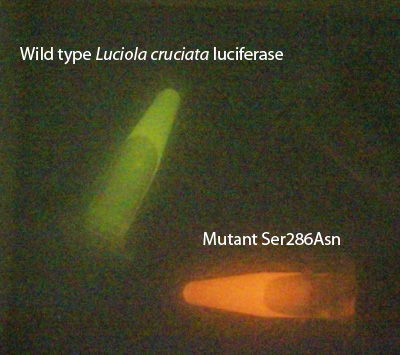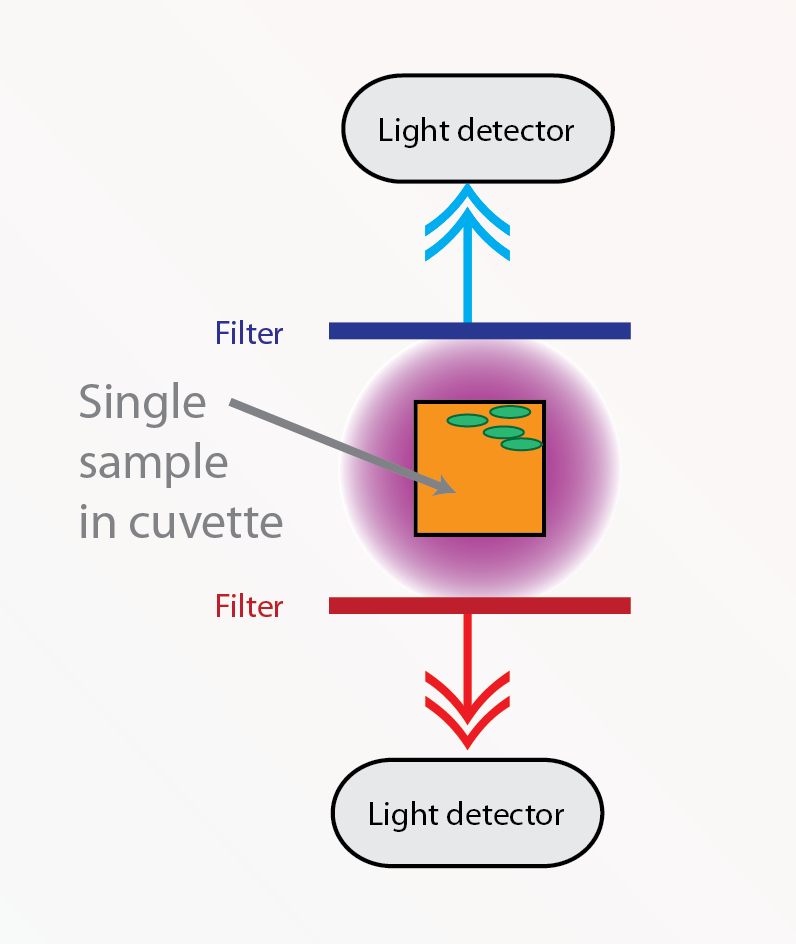Team:Cambridge/Bioluminescence/Colour
From 2010.igem.org
(Difference between revisions)
| Line 1: | Line 1: | ||
{{:Team:Cambridge/Templates/headerMinimalprototype}}{{:Team:Cambridge/Templates/headerbar|colour=#96d446|linkcolour=#6bbe00|title=Project Firefly: Coloured outputs}} | {{:Team:Cambridge/Templates/headerMinimalprototype}}{{:Team:Cambridge/Templates/headerbar|colour=#96d446|linkcolour=#6bbe00|title=Project Firefly: Coloured outputs}} | ||
| - | + | The peak emission wavelength of luciola cruciata luciferase can be altered by single amino acid changes as reported by [http://www.ncbi.nlm.nih.gov/pubmed/1946326 Kajiyama and Nakano]. Different coloured outputs, as well as being aesthetically pleasing, allow the most appropriate wavelength of output for a particular detector to be chosen. By putting different coloured luciferases under promoters which respond to different inputs, co-reporter assays would be possible. | |
{{:Team:Cambridge/Templates/RightImage|image=Cambridge-Mutagenesis.jpg|caption=Comparison of the colour of Luciola cruciata we ordered from DNA 2.0 and it's colour after a single amino acid substitution}} | {{:Team:Cambridge/Templates/RightImage|image=Cambridge-Mutagenesis.jpg|caption=Comparison of the colour of Luciola cruciata we ordered from DNA 2.0 and it's colour after a single amino acid substitution}} | ||
==Methods== | ==Methods== | ||
| - | We used site directed mutagenesis to produce these specific mutations. pSB1C3 with the luciferase and LRE genes is a sizeable plasmid so we performed two separate PCR reactions to generate two halves of the plasmid (using oligonucleotides with the point mutation). PCR products were run on an agarose gel and the relevant bands gel extracted then joined by Gibson Assembly. Cells were transformed with the product. This method avoids cells being transformed with the non-mutated, template plasmid. As an additional check colonies which grew from | + | We used site directed mutagenesis to produce these specific mutations. pSB1C3 with the luciferase and LRE genes is a sizeable plasmid so we performed two separate PCR reactions to generate two halves of the plasmid (using oligonucleotides with the point mutation). PCR products were run on an agarose gel and the relevant bands gel extracted then joined by Gibson Assembly. Cells were transformed with the product. This method avoids cells being transformed with the non-mutated, template plasmid. As an additional check colonies which grew from successfully transformed cells were imaged inside a dark box after addition of luciferin to check the colour of the light produced was as expected. |
{{:Team:Cambridge/Templates/RightImage|image=Bencoreporter2.png|caption=A co-reporter system}} | {{:Team:Cambridge/Templates/RightImage|image=Bencoreporter2.png|caption=A co-reporter system}} | ||
Revision as of 19:03, 26 October 2010

Project Firefly: Coloured outputs
The peak emission wavelength of luciola cruciata luciferase can be altered by single amino acid changes as reported by [http://www.ncbi.nlm.nih.gov/pubmed/1946326 Kajiyama and Nakano]. Different coloured outputs, as well as being aesthetically pleasing, allow the most appropriate wavelength of output for a particular detector to be chosen. By putting different coloured luciferases under promoters which respond to different inputs, co-reporter assays would be possible.


BBa_K325210

BBa_K325209

BBa_K325229

BBa_K325239

BBa_K325249

BBa_K325259

Comparison of the colour of Luciola cruciata we ordered from DNA 2.0 and it's colour after a single amino acid substitution
Methods
We used site directed mutagenesis to produce these specific mutations. pSB1C3 with the luciferase and LRE genes is a sizeable plasmid so we performed two separate PCR reactions to generate two halves of the plasmid (using oligonucleotides with the point mutation). PCR products were run on an agarose gel and the relevant bands gel extracted then joined by Gibson Assembly. Cells were transformed with the product. This method avoids cells being transformed with the non-mutated, template plasmid. As an additional check colonies which grew from successfully transformed cells were imaged inside a dark box after addition of luciferin to check the colour of the light produced was as expected.
Results
We produced...

BBa_K325210
Luciola cruciata LRE and luciferase
This translational unit combines the luciferin regenerating enzyme (BBa_K325202) and red-shifted luciferase (BBa_K325211) from the Japanese firefly, Luciola cruciata. The luciferin regenerating enzyme helps to strengthen and sustain light output.

BBa_K325209
L. cruciata LRE and luciferase (wildtype) under pBAD
This part combines the Luciferin Regenerating Enzyme and luciferase from the Japanese firefly, Luciola cruciata. It is expressed under pBAD.
BBa_K325229
L. cruciata LRE and luciferase (green) under pBAD
This is the same as the part above but with a Val239Ile mutation which green-shifts its emission spectrum.
BBa_K325239
L. cruciata LRE and luciferase (red) under pBAD
This is the same as the part above but instead has a Gly326Ser mutation which red-shifts its emission spectrum.
BBa_K325249
L. cruciata LRE and luciferase (scarlet) under pBAD
This is the same as the part above but instead has a His433Tyr mutation which red-shifts its emission spectrum.
BBa_K325259
L. cruciata LRE and luciferase (yellow) under pBAD
This is the same as the part above but instead has a Pro452Ser mutation which shifts its emission spectrum to peak at a yellow wavelength.
 "
"
